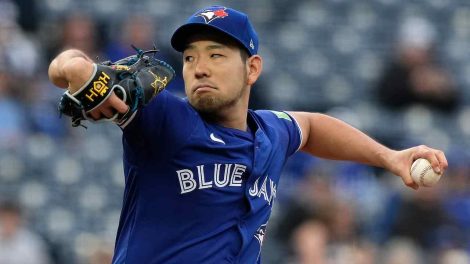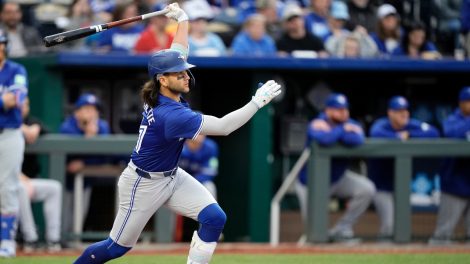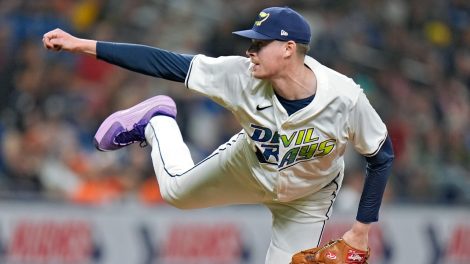TORONTO – When is a deadline not a deadline?
When it’s baseball’s non-waiver trading deadline, of course!
We followed all the news intently on July 31 as the clock ticked down to 4 p.m. ET, with the Los Angeles Dodgers and Texas Rangers getting together on a last-minute deal that sent Yu Darvish out to California well after the Blue Jays had traded Francisco Liriano to Houston and Joe Smith to Cleveland.
Then the deadline passed, and in wrapping up the day’s events, many analysts (including yours truly) talked about the possibility still existing for teams to make trades in August.
That can be confusing, because once a deadline passes that’s supposed to be it, right? Well, no. After Monday, trades can no longer be made without putting players on trade waivers, but if they clear trade waivers, they can still be dealt.
That’s how we’ve seen the August trades that brought players like David Cone and Mike Flanagan to the Blue Jays back in the day and, more recently, Cliff Pennington in 2015 and Dioner Navarro last year.
[snippet id=3526033]
Some people have started to mistakenly call Aug. 31 the “waiver trade deadline” because, after all, if there’s a non-waiver trade deadline, the next one would have to get rid of the “non-“, but that’s not correct. There is no waiver trade deadline, players who clear trade waivers can be dealt right up until the last day of the season. But unless they join their new team before Sept. 1, they’re not eligible for the playoffs.
The Blue Jays picked up Darwin Barney from the Dodgers in September of 2015, after Kevin Pillar broke Troy Tulowitzki‘s shoulder blade with his chin. Barney helped the Jays win the AL East that year, but wasn’t eligible to play in the playoffs. Way farther back, the Jays traded for Bud Black in September of 1990 in an ill-fated attempt to help get into the post-season. Had they made it, he wouldn’t have been able to play, either.
Trades can be made – with waivers – all the way until the end of the season, but the playoff eligibility deadline is Aug. 31. So how do you make a trade in August?
Well, first you have to put the player you want to trade on waivers. But these aren’t ordinary waivers, the ones where if a player gets claimed, you lose him. August waivers, or trade waivers, are recallable. So if a player gets claimed and his team wants to keep him, they can pull him back off waivers and it’s like the whole thing never happened. But you can only do that once. Try to run a guy through a second time and you lose him if he gets claimed.
Since trade waivers are recallable, pretty much every player in the major leagues will be placed on them at some point in time during the month of August (yes, even the guy who you’re thinking “even him?” about right now). There’s no reason not to do it, because since players can be called back there’s no actual risk to putting them on waivers. General managers really dig flexibility, and having players clear trade waivers gives them that as well as it lets them know who they are free to trade and, on players they have to recall, what teams were interested in acquiring them – which is good to know going into the off-season when they might be more inclined to deal them.
What this means is that over the course of the next month, you’ll see some headlines that say “Superstar X is on waivers!” and you’ll feel the urge to get excited or angry or not believe it, but just remember that well over 90 per cent of the players in the major leagues will go on waivers this month, if not all of them, and hardly anyone will be awarded to another team on a straight waiver claim. That only happens on very rare occasions. The only ones that jump to mind are Jose Canseco in 2000, when the Yankees put in a claim and the Devil Rays said “take him”, and Alex Rios, who went from the Blue Jays to the White Sox in the same fashion in 2009.
[relatedlinks]
I had thought that the Blue Jays let San Diego take Randy Myers on a straight waiver claim in 1998, when the Padres claimed him in order to try to block the Atlanta Braves – a potential playoff foe – from getting him, but it turns out the Jays and Padres worked out a waiver trade.
So what’s a waiver trade? Glad you asked.
Players can be traded after the non-waiver deadline if they clear trade waivers, but they can also be moved if they get claimed, though only to the team that claims them.
Once a player gets claimed on recallable waivers, his original team has 72 hours to decide whether to recall him. Sometimes, those 72 hours will be spent trying to work out a trade with the claiming team. The leverage the original team has is that if it doesn’t get a return that it likes, it will simply pull the player back off waivers and the claiming team loses the opportunity to acquire him. Of course, that leverage only exists if the claiming team believes that the original team will recall the player but again, very rarely does a team say, “go ahead, take him.”
Players who have 10-and-5 rights (10 years of service time, at least the last five with the same team), such as Jose Bautista, can be placed on trade waivers, but can’t be awarded to another team on a straight waiver claim without their permission.
Bautista is a candidate to be traded in August, though his 10-and-5 rights make it difficult, as does his production so far this season. Marco Estrada is another possibility. Both of them should clear trade waivers, given how much money they make.
August won’t be as busy as July, trade-wise, but more than a few deals will still be made before month’s end.










